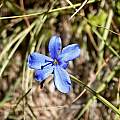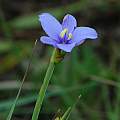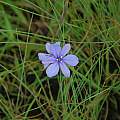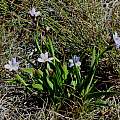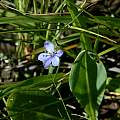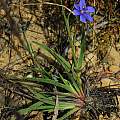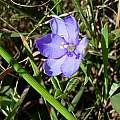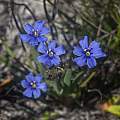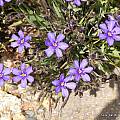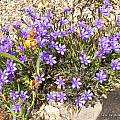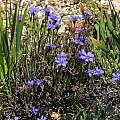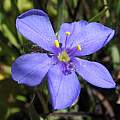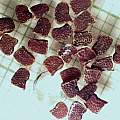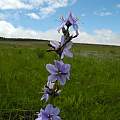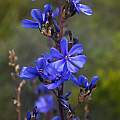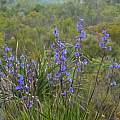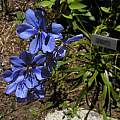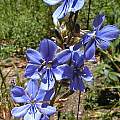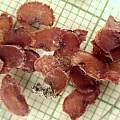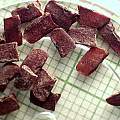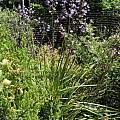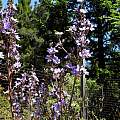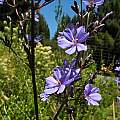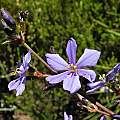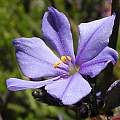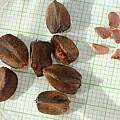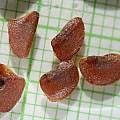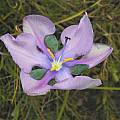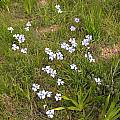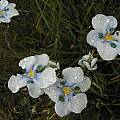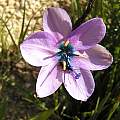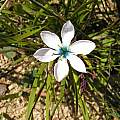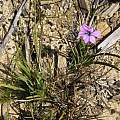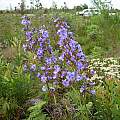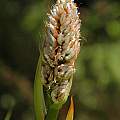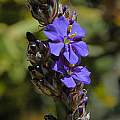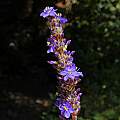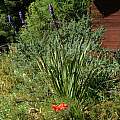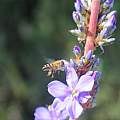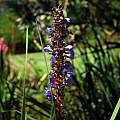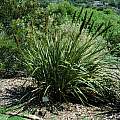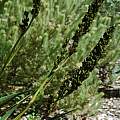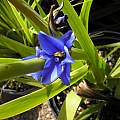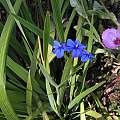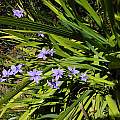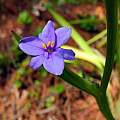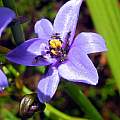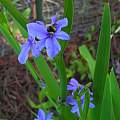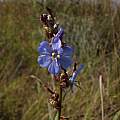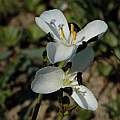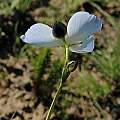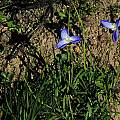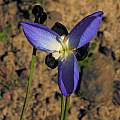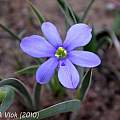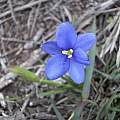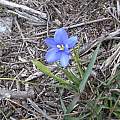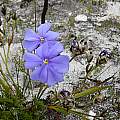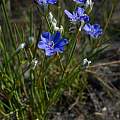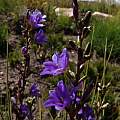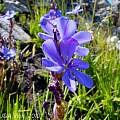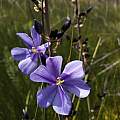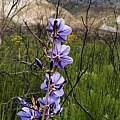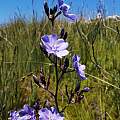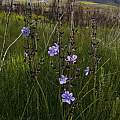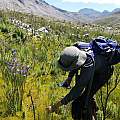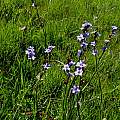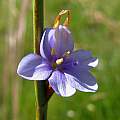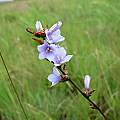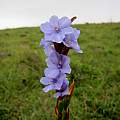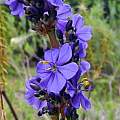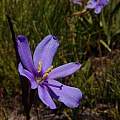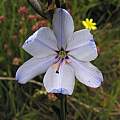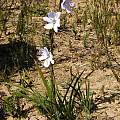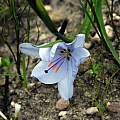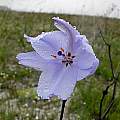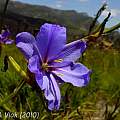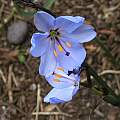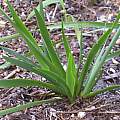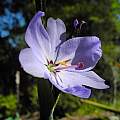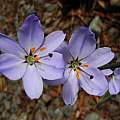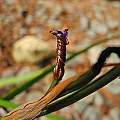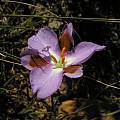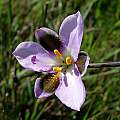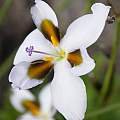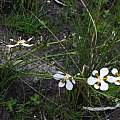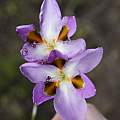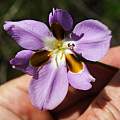Aristea is a genus of evergreen rhizomatous perennials in the Iridaceae family found in Sub-Saharan Africa and Madagascar. Most are rarely grown although Aristea ecklonii is a common garden plant.
Aristea abyssinica Pax is found from the Eastern Cape, South Africa to Tropical Africa where it grows in on rocky outcrops, in grassland, and marshy areas. It has narrow leaves clustered at the base and sky blue, violet, deep red, or pink flowers. Height is 10-15 cm. Photo #1 taken by Cameron McMaster in the Eastern Cape. Photos #2 and 3 taken January 2010 by Mary Sue Ittner at Satansnek Pass. Photos 4 and 5 taken by Cameron McMaster and Bob Rutemoeller January 2010 at Naude's Nek.
Aristea africana (L.) Hoffmanns. is an evergreen short plant, 10 to 15 cm high, with blue flowers and a style with three fringed lobes. It is found on sandy flats and mountain slopes in the winter rainfall area of South Africa. Flowering occurs late spring to early summer. The first photo was taken by Mary Sue Ittner September 2006 near Bainskloof and the second was taken by Cameron McMaster near Napier in the Overberg. The last photo by Christopher Whitehouse was taken in the Phillipskop Mountain Reserve near Stanford in South Africa.
The first four photos were taken in the UC Botanical Garden. The first two were contributed by the garden and the next two by Nhu Nguyen showing growth habit and a closeup of a flower. The last microscope photo by M. Gastil-Buhl shows that seed from Silverhill are dark brown, angular and about 1.5 mm x 2.5 mm with a dimpled texture.
Aristea angolensis Baker is distributed in Tropical Africa and South Africa (eastern Nigeria and western Cameroon, Ethiopia, Angola, Zaire, Zambia, Malawi, Zimbabwe and South Africa as far south as Eastern Cape Province) where it grows in rocky and wet sites, seeps, seasonally flooded valley grassland or shallow marshes at 1750-2700 m. Plants grow from 25 to 90 cm high with linear to narrowly lanceolate leaves and a branched stem with blue more or less sessile flowers. Photo from Rod Saunders taken in KwaZulu-Natal in grassland.
Aristea bakeri Klatt syn. Aristea confusa Goldblatt, syn. Aristea macrocarpa G.J.Lewis, syn. Aristea paniculata Baker is an evergreen rhizomatous plant found on stony sandstone slopes over a broad range from the northwestern, southwestern to the eastern Cape province of South Africa. It has linear to sword shaped fibrotic leaves (6-20 mm wide), rounded stems that are usually much branched, and spathes and bracts that are rust brown with transparent margins. It grows from 0.6-1.79 meters and flowers late spring to summer. Peter Goldblatt states it is not a great rebloomer. In the wild it needs fire to stimulate bloom. Photos below were taken by Christopher Whitehouse, in the Phillipskop Mountain Reserve near Stanford.
The plant grown from Silverhill Seed that bloomed for the first and only time in Northern California in May-June 2004 pictured below in photos 1 and 2 by Mary Sue Ittner is a short plant with blue short-lived (not even all day) flowers, but many were produced. Photo 3 by M. Gastil-Buhl shows seed from Silverhill, cataloged as Aristea macrocarpa, a synonym for A. bakeri, on a 1 mm grid. The seeds are D-shaped and flat with a frayed edge. Photo 4 by M. Gastil-Buhl shows Silverhill seed cataloged as Aristea confusa, another synonym of A. bakeri but with distinctively different seed.
Photos below from Mary Sue Ittner show the first blooming of a plant that bloomed for a very long time in the spring of 2012 (probably from seed sown in either 2004 or 2005). The tag was misplaced, but Peter Goldblatt is of the opinion that it is this species. It is quite a tall plant unlike the one pictured above, but is growing where it gets much more light. Flowers were short lived, opening in the morning and closing later in the day, but most mornings for more than a month there was quite a display of new flowers.
These seed pods and seeds are from the plants shown above grown by Mary Sue Ittner, photographed by M. Gastil-Buhl. Note that these seeds look a bit different from the ones photographed above that are also supposed to be this species, but look more like the ones cataloged as A. confusa which was the name given to seeds of this species Mary Sue grew.
Aristea biflora Weim. is native to the southwest Cape of South Africa. It is an evergreen, growing from 20 to 40 cm high. It has large lilac to purple flowers with transparent to translucent bronze windows on the lower margins and flowers August to October. These pictures were taken September 2003 near Caledon by Bob Rutemoeller.
Aristea cantharophila Goldblatt & J.C.Manning grows on clay and granite slopes in fynbos or renosterveld in the southwest Cape, South Africa. It is an evergreen rhizomatous species that grows from 20 to 40 cm and flowers August-September. These pictures were taken near Paarl in September 2003 by Bob Rutemoeller. Flowers are lilac to cream with a dark center.
Aristea capitata (L.) Ker Gawl. syn. Aristea major Andrews is an evergreen rhizomatous species that grows up to 1.5 meters high. It is a very striking species with many blue flowers on the flowering spike. It occurs over a wide range of both the winter rainfall areas of South Africa into summer rainfall areas of the southeastern Cape growing on mountain slopes and blooming spring to summer. The first photo was taken by Cameron McMaster in the southern Cape. The next pictures were taken by Mary Sue Ittner of plants growing in her northern California garden and blooming finally after many years. The first one shows the forming flowering stalk and other pictures show the flowers that opened for a short time over a long period. These flowers attract honey bees, as shown in the sixth photo by M. Gastil-Buhl of the first bloom from a plant obtained as a 4" seedling three years prior. The blooming period spanned several weeks in May.
Photos were taken by Mary Sue Ittner January 2010 in the Kirstenbosch National Botanical Garden.
Aristea ecklonii Baker is a summer rainfall Aristea. It grows on forest margins, streambanks, grassland, scrub from the Eastern Cape, South Africa to Tanzania. It has basal leaves in a fan and mauve-blue flowers and grows to 50 cm high. It flowers early in the morning and the flowers fade by afternoon, but it can bloom off and on throughout the year and the color of the flowers is quite striking. This species has a reputation for being weedy, even when grown in a Mediterranean climate. Ironically it grows and flowers much better than winter rainfall species. Removing seedheads is important or you'll have a lot of seedlings in your garden. It will come back if you cut it back hard we have found if the leaves are looking unattractive. Photos by Bob Rutemoeller and Mary Sue Ittner. The last two photos show why in California it sets seeds so well.
Aristea galpinii N.E.Br. ex Weim. is native from Mpumalanga to Swaziland where it grows in grassland at 400 - 1690 m and flowers in summer. Growing from .25 to 1 m it has leaves with rusty brown margins and bright blue flowers. Photo from Rod Saunders.
Aristea lugens (L.f.) Steud. grows on low granitic hills in renosterveld in the southwest Cape, South Africa. Plants are evergreen and rhizomatous and grow from 30 to 40 cm high with striking pale blue to white flowers with dark blue-black outer tepals. Photos were taken near Brackenfell August 2006 by Bob Rutemoeller and Mary Sue Ittner in an area that had burned earlier.
Aristea nana Goldblatt & J.C.Manning was described in 2005. It is a spring-flowering species native to the eastern half of the southern African winter rainfall zone and adjacent southern edge of the summer rainfall zone where it grows on sandy and rocky sandstone slopes, in arid, marginal fynbos. It is a small species to 15 cm with sword-shaped to linear leaves with narrow translucent margins, sometimes flushed red, and arranged in a fan and small dark blue, usually solitary flowers. It is very similar to Aristea pusilla, but has an unbranched flowering stem, blue-grey leaves, and a much longer flowering stalk. The first photo from the book Plants of the Klein Karoo courtesy of Jan and Anne Lise Schutte-Vlok. The next two photos from iNaturalist were taken by Jenny Potgieter near Mossel Bay in April and shared under a CC BY-NC license.
Aristea oligocephala Baker is found on sandstone slopes from the Hottentots Holland Mountains to Bredasdorp (South Africa.) It is a short plant, 15 to 25 cm high, and flowers November-January. Flowers are blue and the style has three fringed lobes. The first photo was taken near Napier in the Overberg by Cameron McMaster. The second photo by Christopher Whitehouse was taken in the Phillipskop Mountain Reserve near Stanford.
Aristea racemosa Baker is an evergreen rhizomatous species growing to 40 cm high on rocky sandstone slopes from Paarl in the southwestern Cape to the southeastern Cape, South Africa. It flowers from late spring to midsummer and has blue flowers with a minutely three notched style and cylindrical shiny leaves with an almost spiny tip. Photos from the book Plants of the Klein Karoo courtesy of Jan and Anne Lise Schutte-Vlok.
Aristea rigidifolia G.J.Lewis grows on sandy flats in the Southwest Cape, South Africa. It is an evergreen rhizomatous plant that grows to 1.5 m. Plants have rounded stems with short branches, blue flowers with a minutely three-notched style and rusty ovate spathes and bracts. Capsules are three-winged. This species is rare. Photos from iNaturalist were taken by Mark Johnson in the Overberg in October the first season after fire in moist, sandy habitat, alongside orchids, and shared under a CC BY-NC license.
Aristea schizolaena Harv. ex Baker is an evergreen rhizomatous species that grows in coastal grassland in the southeastern Cape, South Africa. It grows to 80 cm high and has blue flowers. The first four photos by Cameron McMaster were taken in the Eastern Cape. The last photo from Mary Sue Ittner of one grown from seed.
Aristea simplex Weim. is an evergreen rhizomatous species growing to 50 cm on clay flats and lower slopes in renosterveld and distributed from the southwestern Cape to the Swartberg Mountains. It has narrow linear leaves and pale blue flowers facing to the side and flowers in spring. Photo from the book Plants of the Klein Karoo courtesy of Jan and Anne Lise Schutte-Vlok.
Aristea spiralis (L.f.) Ker Gawl. is found growing on rocky sandstone and granite slopes from the Cape peninsula to Knysna (South Africa.) The large flowers face to the side and are white to blue on a flattened stem and occur spring into early summer. Plants range from 20 to 75 cm high with broad flat leaves. The first two photos were taken by Bob Rutemoeller near Paarl September 2003. The third was taken near Bainskloof September 2006 by Mary Sue Ittner. The fourth was taken by Cameron McMaster near Fairfield in the Overberg and the last from the book Plants of the Klein Karoo courtesy of Jan and Anne Lise Schutte-Vlok.
Photos below were taken by Mary Sue Ittner. The first two photos of the leaves and flowers show a plant blooming for the first time in her California garden. For many years later she never saw another flower, although the flowers only last a day and she could have missed them. In 2015 she discovered the plant blooming a number of days over several months. After the flowers bloom, the spent flower coils and later seed pods are formed.
Aristea teretifolia Goldblatt & J.C.Manning is a spring-blooming species that grows in the southwest Cape of South Africa on low clay hills in renosterveld. Growing from 20 to 40 cm high, it has linear leaves and large flat, lilac to cream flowers. Tepals are unequal; the inner has a large dark mark toward the base. The first picture was taken September 2003 near Boskloof by Bob Rutemoeller and the second one near Napier in the Overberg by Cameron McMaster. The final four photos were taken in a renosterveld reserve near Stanford by Michael Mace. Editing Main.Aristea Emphasized (italic)Strong (bold)Link to internal pageLink to external pageInsert imageAttach fileBig textSmall textSuperscriptSubscriptHeadingHeadingHorizontal ruleCenter
